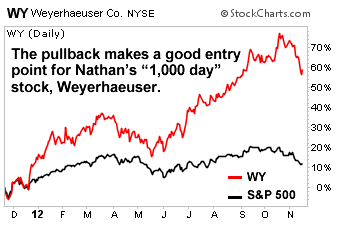A Wealth Cycle for the Ages
Here’s the question I asked all of our strategists recently: What’s the single stock you would buy now if you knew that the next thousand trading days would turn out to be a wash for the broader market? In other words, what stocks will rise, even if the market is flat?
That’s been the topic of conversation recently after one of our researchers came across a chart of the “17.6-year wealth cycle.”
Have you heard about this phenomenon?
Here’s the premise: Every 17 to 18 years the stock market shifts gears, going from a period of sideways movement to a bull market.
Then the pattern repeats.
And then it repeats again. On average, it’s 17.6 years when not much of anything happens to the broad market, followed by 17.6 years of better-than-average returns. Supposedly, this has been going on for more than a century.
I was skeptical. Who wouldn’t be?
After more than three decades in the markets, I’ve seen more than my share of “can’t miss” indicators.
Some market predictors are better than others, but sooner or later they all prove fallible.
That’s why I was hesitant when I first heard about the alleged “17.6-year wealth cycle.” Then I saw the chart below…

As you can see, the cycles occur virtually on cue, going back 112 years to 1900.
The credit for first spotting this pattern reportedly goes to Art Cashin, director of floor operations for UBS Financial Services and a frequent CNBC market commentator.
When stocks are in the growth cycle, Cashin says, “You can pick almost any stock you want and it will go up.”#-ad_banner-#
But if the past is any indicator, you can see in the upper right-hand portion of the chart that there’s likely a little more sideways movement to play out in the current cycle — about four years, or a thousand trading days.
There are always profits to be made, of course, even in the sideways cycles. To name just a couple recent ones: The Daily Paycheck’s Amy Calistri booked a gain of 29.8% since April in the country’s largest newspaper company, Gannett (NYSE: GCI), and High-Yield International’s Paul Tracy is celebrating a 31.9% year-to-date increase in Diageo (NYSE: DEO), the London-based distiller.
Overall, however, the pickings are slimmer in the “lean” times. Since 2000, the beginning of the current cycle, the Dow Jones Industrial Average has risen by a paltry 7%, for a meager gain of just 0.5% annually.
Hence, my aforementioned challenge to the StreetAuthority experts. What can our readers invest in right now, as we head into the final stretch of this sideways market? Or, put another way, what investments look particularly attractive heading into the next “fat” cycle?
Their recommendations ranged from deeply discounted blue-chips to a unique stock that essentially acts as a hedge fund, letting investors tap into a luxury usually reserved for millionaires.
But one of the most intriguing “cycle” picks came from Nathan Slaughter, stock market strategist for Scarcity & Real Wealth.
Nathan recommended a pure play on the fledgling U.S. housing recovery. This is a company whose shares are changing hands at less than a third of what they were fetching five years ago.
A big reason for Nathan’s vote of confidence is the unique characteristic of this company’s core product: wood.
To hear Nathan tell it: “The housing bust and subsequent slump in new home construction put a severe dent in demand for lumber, which meant fewer logs being hauled out of the nation’s forests. For other companies, these types of slowdowns often mean that inventory is collecting dust in a warehouse somewhere, resulting in damaging asset write-downs.
“But when a timber company sees orders dry up, it simply defers its harvest. The ‘inventory’ remains standing and is allowed to grow larger (and more valuable) with each passing year. So during the lean times, a timber company may see a temporary dip in accounting profits. But the intrinsic net worth of the business (the value of its trees) continues to grow.
“And those sales aren’t lost — they are simply delayed until demand returns. When that day comes, the unharvested acreage will contain bigger trees that fetch even greater profits than before. I believe that time is now.”
The company: Weyerhaeuser (NYSE: WY), a real estate investment trust (REIT) with interests in wood products and real estate in addition to timberland. This afternoon, Weyerhaeuser closed at $25.38 a share; Nathan sees the stock retaking $40 — with a bona fide shot at $50 — within the next few years as pent-up housing demand gets satisfied.
Nathan’s full write-up on Weyerhaeuser — along with separate “wealth cycle” picks from Amy, Paul, Andy Obermueller and Carla Pasternak — are being made available to new and existing members of StreetAuthority’s Lifetime Wealth Alliance.
If you haven’t heard of the Lifetime Wealth Alliance, it’s StreetAuthority’s exclusive investment club that offers access to all current and future advisories and special reports for a one-time fee.
On November 30, StreetAuthority plans to drastically increase the price of this service for new members.
But for the next few days you can still lock in the current price… access all of StreetAuthority’s publications… learn all the details about the 17.6-year cycle… and receive the favorite pick of each editor for the next 1,000 days. Follow this link to learn more about this opportunity, including more details about the 17.6-year cycle.
|
|
